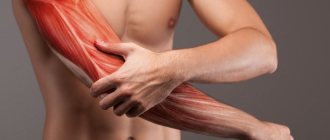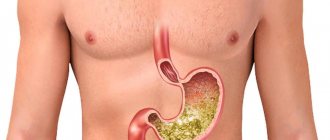Ways to manifest flatulence
Flatulence in adults is also characterized as swelling or bloating, during which discomfort occurs in the abdominal area, accompanied by rumbling, belching, and sometimes constipation or diarrhea. Attacks of spasms and pain are possible. Flatulence can also occur with the constant release of gases that have an odor. The condition improves significantly after a person has bowel movements. As a rule, such disorders appear in the afternoon, when the digestive system is actively working.
If the accumulation of gases occurs in a certain part of the intestine, so-called local flatulence, pain is observed. When gases are retained at the bend of the intestine, where the spleen is, in addition to the standard manifestations, pain is felt on the left side and severe bloating. Gases in the liver area are manifested by a feeling of overeating and pain on the right side under the ribs and shoulder blade.
flatulence in adults
With flatulence, which occurs due to dysfunction of the small intestine, bloating is observed, while the colon is characterized by a feeling of fullness, distension on the sides. In addition to the standard manifestations, the patient experiences vomiting, shortness of breath, unpleasant belching, heart pain, rapid heartbeat, and general weakness.
Flatulence, which is observed over a long period of time, not only has a detrimental effect on human health (heart problems, insomnia, weakness), but also limits the ability to communicate with other people.
Cure for bloating - the right treatment
For gases and bloating, the main thing is to complete the correct treatment on time.
With the consent of the doctor, the following drugs can be used:
- Defoamers to destroy gas bubbles predominantly in the intestines:
- Simethicone;
- Espumisan;
- Bobotik;
- Disflatil;
- Antiflat;
- Lannacher.
Dimethicone;
- No-shpa;
Spasmonet.
- Mezim forte contains active ingredients, lipase, and creatinine. It does not have an absorbent effect, but leads to a rapid decrease in hypersecretion, relieving the feeling of heaviness, bloating, and acute pain due to accumulated gases in the abdominal cavity;
Motilium supports the activation of peristalsis, the removal of gases and the relaxation of soft muscles.
- Lactofiltrum;
Active carbon.
- Duspatalin is a prokinetic, antispasmodic to eliminate abdominal cramps and flatulence, normalize bowel movements, suppress harmful microflora in the intestines, remove gases and toxins naturally;
Eglonil with a neuroleptic effect to normalize motor activity, has a mild and gentle effect on the 12th duodenum, reducing gas formation and the rapid removal of gases;
- Activated carbon to eliminate gases accumulated in large quantities, bloating, nausea, vomiting, diarrhea, flatulence;
Polysorb as a sorbent for cleansing the intestines of stagnation and normalizing microflora;
- Bifidumbacterin to restore intestinal microflora, increase immunity, eliminate gases and spasms. Recommended for pregnant women and children over 3 years old. Contraindications: hypersensitivity;
Almagel for flatulence, treatment of heartburn. Contraindications: pregnancy, Alzheimer's disease;
Causes of gas formation in the gastrointestinal tract
Despite the fact that flatulence is classified as a problem associated with the gastrointestinal tract, there are initial stages that negatively affect the condition of the intestines, by eliminating which you can independently eliminate the accumulation of gases.
Physiological reasons
- Frequent consumption in the diet of foods that affect gas formation (brown bread, kvass, legumes, cabbage, fats). This leads to the fact that the intestines cannot cope with the timely removal of accumulated gases.
- If you frequently swallow air while eating, this happens when you eat hastily or smoke.
- Flatulence in most people is caused by problems with the gastrointestinal tract. But a similar phenomenon is also often observed after 50 years, when the intestinal walls atrophy, they weaken and become prominent, which contributes to the accumulation of gases.
During pregnancy
- In the third trimester, irregular gases often occur, accompanied by belching, constipation and heartburn. The reason for this is compression of the intestines due to an enlarged uterus.
- Progesterone, produced by the placenta to maintain pregnancy, has a relaxing effect, which causes gas retention.
- A woman expecting a baby increases the load on the pancreas and liver. This leads to digestive disorders and increased formation of gases.
- If the breakdown and absorption of substances by the body is impaired, insufficient fermentation of the esophageal fibers occurs, which provokes fecal retention and the inability to remove excess gases.
Infectious diseases
Inflammatory processes that occur under the influence of microorganisms (pathogenic) and affect the large and small intestines, leading to disruption of the digestive system. The result is the inability to move gases through the intestinal walls.
- Acute intestinal infections, in which diarrhea, nausea, vomiting and colic occur. The accumulation of gases occurs during rotavirus infection, dysentery, salmonellosis, gastritis and other gastrointestinal lesions.
- Intestinal candidiasis. When immunity decreases, fungal flora is activated, which is an ideal environment for flatulence.
- An intestinal infection caused by Giardia (single-celled parasites) that live in the lumen of the small intestine. If this cause of flatulence is present, the patient will lose a lot of weight, and there will be increased excitability and irritability.
- The presence of helminthiases in the body provokes swelling and bloating. In advanced forms, diarrhea with blood and rectal prolapse are characteristic.
Dysbacteriosis (changes in the normal intestinal flora) becomes the main cause of the development of infectious diseases that cause flatulence. There is a disruption of natural processes that go into the fermentation stage, thereby provoking gas formation.
Pathology of the large intestine
- Inflammatory processes for a long time, which were not treated in any way.
- In the presence of benign tumors, intestinal polyps, which slowly but progress. Constant flatulence, blood in the stool, acute fighting sensations can become the first signs of the development of cancer.
- With enlargement of the colon (congenital or acquired). The pain occurs both locally and diffusely, which makes it difficult to accurately determine the location of the anxiety in the gastrointestinal tract.
- When the structure of the intestinal wall is disrupted, it protrudes and the formation of air cysts. These are the reasons why the process of gas removal from the intestines slows down.
Diseases of the stomach and esophagus
- Flatulence can occur with lesions of the digestive tract (hernia, reflex disease).
- Gastritis with high acidity is also a cause of poor gas removal.
Purulent processes
- Peritonitis.
- Chronic appendicitis, abscess.
Problems with the genitourinary system
- Acute prostatitis negatively affects nearby organs, that is, the intestines.
- Severe form of pyelonephritis, renal colic, during which compression of the intestines occurs.
Endocrine system disorders
- Low thyroid hormone levels.
- Premenstrual syndrome.
causes and symptoms of flatulence
Bloating due to changes in diet
Stomach cramps often occur in people who completely abstain from meat, that is, vegetarians. The body simply does not have time to get used to the new diet.
Begins to react inadequately with the manifestation of unpleasant symptoms: constipation, loose stools, diarrhea, nausea, vomiting, gurgling, gurgling of gases in the stomach.
Sometimes flatulence and colic lead to food allergies and the entry of allergens into the body. The products include the main ones: tangerines, strawberries, eggs, spices, honey, fish, meat. Skin allergy symptoms: rashes, eczema.
Gastrointestinal disorders sometimes occur:
- intestinal flatulence;
- symptoms of dysbiosis;
- constipation;
- nausea, vomiting;
- diarrhea;
- gas formation;
- pain in the peritoneal cavity.
If gas formation begins to bother you, you should reconsider your diet, giving up foods that contribute to increased bloating:
- salt;
- Oatmeal;
- milk;
- beer;
- mushrooms;
- fresh cow's milk;
- apricots;
- onion;
- vegetables;
- tomatoes;
- beer;
- broccoli;
- pears;
- cheeses;
- braised cabbage;
- apples;
- watermelon;
- Garlic;
- black bread;
- buckwheat grain;
- bananas;
- corn;
- cottage cheese;
- rice;
- pearl barley.
What examinations need to be performed?
Due to the numerous causes of flatulence, it is difficult to immediately determine a diagnostic method to identify the source of the problem. The patient’s initial visit takes place at an appointment with a local therapist, who will give a referral for further examination by a gastroenterologist. Most of the patients who complained of gas accumulation had gastrointestinal disorders.
The list of necessary examinations includes:
- After a visual examination and palpation of the swellings, the patient is referred for colonoscopy and endoscopy. Having received the main indicators, a biopsy is taken from the stomach to study the problem in more detail.
- An ultrasound of the abdominal cavity allows you to see a full picture of what is happening, possible deviations, the condition of the organs, the presence of a cyst. If necessary, the doctor conducts an additional ultrasound examination of the liver, stomach, and pancreas.
- Examination of the abdominal cavity using an X-ray machine. The walls of the large and small intestines are visible.
- Passing pH measurements to identify disorders of gastric secretions.
- Blood and stool tests, which are given and examined in the laboratory.
What to do if alarming symptoms and discomfort accompanying bloating appear?
First of all, it is necessary to understand and identify the causes of gas formation and flatulence in the lower abdomen.
Perhaps the reason is a chronic disease or poor diet.
If bloating has become a daily obsessive phenomenon, this is already a cause for concern and a threat to the body.
Especially if there is prolonged diarrhea associated with dehydration.
It is important to quickly respond to unpleasant symptoms and, if necessary, consult a doctor.
You can relieve symptoms by taking sorbents or activated charcoal to reduce the amount of intestinal gas and remove toxins.
The most important thing is to recognize the problem associated with intestinal motility at the initial stage. Of course, in case of fluid congestion, you can take a laxative to quickly clear the intestines of stool. In particular, for constipation, taking raw vegetables, fruits, and herbal infusions is suitable.
It is necessary to review the diet, give up foods that cause the formation of large amounts of gas, smoking, alcohol, chewing gum, and carbonated drinks.
Often stress or tense nerves increase the accumulation of gases, so it may be time to see a psychologist. If there is a suspicion of cancer, then an oncologist.
If gases in the abdominal cavity are constantly disturbing, it is necessary to conduct research and other laboratory and instrumental examination methods.
Especially:
- Blood tests for the latent course of inflammatory processes in the digestive system;
- Ultrasound, x-ray to examine the peritoneal cavity;
- blood tests for biochemistry.
You cannot ignore alarming symptoms: vomiting, severe diarrhea, fever, rectal bleeding.
Symptomatic therapy for flatulence
The number of flatulence is reduced or even disappears after proper adjustments to a person’s diet are made. With the obligatory limitation of foods that contribute to bloating and gas formation. Also, when eating, you should be in a calm environment, do not smoke at this time, and chew thoroughly. Avoid dry food and include first courses in your diet once a day. Simple physical exercises will have a beneficial effect on the removal of gases in the intestines. Until the cause of the disorder is finally determined, you can save yourself with absorbents, carminatives and other drugs.
If frequent bloating is accompanied by severe pain, colic or abnormal bowel movements, immediately go to the hospital for consultation with a specialist.
What is increased gas formation?
Bloating brings considerable discomfort
Increased gas production is also called flatulence. In medicine, flatulence is understood as a symptom of gastrointestinal diseases, characterized by excessive gas production in different parts of the intestine.
Most often, increased gas formation is associated with the activity of intestinal bacteria. Overfilling of the intestines with gas is accompanied by bloating, pain and discomfort.
Flatulence can be of two types: with the release of gas and without the release of gas. The first type is characterized by active release of gas from the rectum. The second type is characterized by increased bloating.
When to see a doctor?
Chronic flatulence may be associated with dangerous pathologies that require medical supervision. You should consult a doctor if the following symptoms appear:
- Significant weight loss.
- Pale skin, constant weakness, dizziness, loss of appetite (symptoms of anemia).
- Constant diarrhea.
Diagnostics can reveal the most unexpected causes of pathological conditions. Thus, the causes of bloating and gas are usually related to the characteristics of the intestinal microbiome.
Intestinal gas
Gas formation in the intestines is a normal physiological process. The greatest contribution to this process is made by intestinal bacteria, which produce gas at different stages of metabolism.
Undigested food products enter the human large intestine, which feed the bacteria. The normal microflora of the large intestine produces a moderate amount of gas, but if the balance of bacterial colonies is disturbed, flatulence may develop.
Intestinal gases can consist of carbon dioxide, hydrogen, methane, nitrogen and sulfur dioxide. The latter chemical component gives the gas an unpleasant odor. This gas is typically a byproduct of the enzymatic breakdown of carbohydrates by bacteria.










